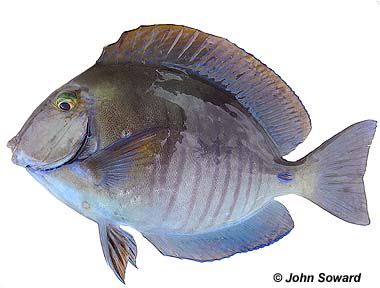
Acanthurus coeruleus
This oval-shaped tropical reef fish is a popular aquarium and bait fish that has three color phases of its life. It isn’t often consumed because of the strong odor and chance of ciguaterra poisoning. Handle with care if catching because of the sharp spine hidden in the caudal peduncle (narrow area just before the tail).
These vegetarians play an important role on the reefs by eating the algae that can grow over the coral and kill it.
Order – Perciformes
Family – Acanthuridae
Genus – Acanthurus
Species – coeruleus
Common Names
English common names include blue tang, blue barber, blue doctor, blue doctorfish, blue tang surgeonfish, blur tang, yellow barber, and yellow doctorfish. Other names are barbeiro (Portuguese), barbero (Spanish), barbero azul (Spanish), chirurgien bayolle (French), chirurgien bleu (French), cirujano (Spanish), doctor (Spanish), medico (Spanish), navajon azul (Spanish), pokolec turkusowy (Polish), sangrador azul (Spanish), and siwizye (Creole).
Importance to Humans
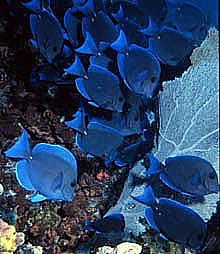
The blue tang is of minor commercial fisheries importance, however it is occasionally utilized as a bait fish. The flesh has a strong odor and is not highly prized. This fish may cause ciguaterra poisoning if consumed by humans. However, blue tangs are collected commercially for the aquarium trade. An unwary human who tries to handle the blue tang risks the chances of being badly cut by the caudal spine. These spines, on both sides of the caudal peduncle, are extended from the body when the fish becomes excited.
The quick, thrashing sideways motion of the tail can produce deep wounds that result in swelling and discoloration, posing a high risk of infection. The pain can last for hours, until eventually subsiding into a dull ache. It is believed that some species of Acathurus have venom glands while others do not. The spines are used only as a method of protection against aggressors.
Conservation
> Check the status of the blue tang at the IUCN website.
The IUCN is a global union of states, governmental agencies, and non-governmental organizations in a partnership that assesses the conservation status of species.
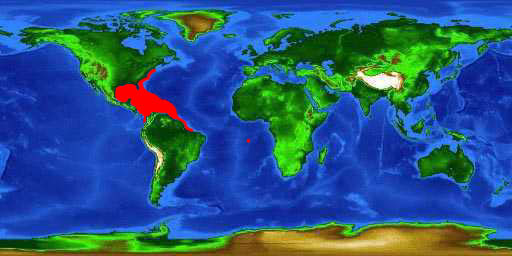
Geographical Distribution
The blue tang is found in the western Atlantic Ocean from New York and Bermuda to the Gulf of Mexico, south to Brazil. It is abundant in Florida, Bahamas, and the Caribbean Sea. In the eastern Atlantic Ocean it occurs near Ascension Island.
Habitat
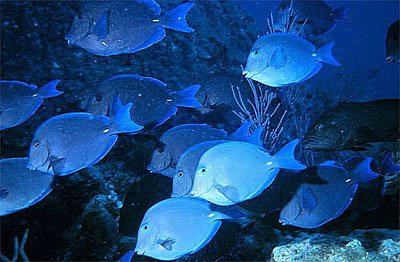
Tangs are found in coral reefs and inshore grassy or rocky areas at depths of 6-131 feet (2-40 m). In coral reefs, blue tangs live in holes and crevices where they are sheltered from predators while they sleep at night. The blue tang lives singly, in pairs, or in small groups of up to 10 or 12 individuals, although occasionally it forms large aggregations that forage about the shallow reefs, grazing on algae. These aggregations sometimes include doctorfish (Acanthurus chirurgus) and other surgeonfish.
The juvenile blue tang is rarely seen on the reef due to its small size and need for constant cover from predators. The intermediate phase with the blue body and yellow tail is often observed on reefs while young adults are abundant everywhere on the reef.
Biology
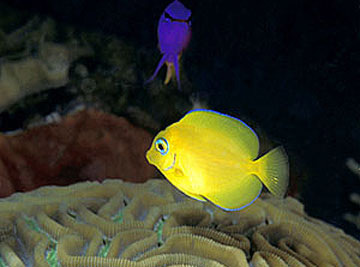
Distinctive Features
The blue tang is a high-bodied, compressed, pancake-shaped fish with a pointed snout and small scales. The eye is located high on the head and the mouth is small and low on the head. The dorsal fin is continuous. Of particular interest is the distinct yellow caudal spine located at the base of the tail on either side of the body, a characteristic shared with other surgeonfish. This spine fits into a horizontal groove and can be extended and used to fend off aggressive encounters.
Coloration
This fish has three color phases. In its juvenile phase, it is bright yellow, changing to a mixture of yellow and blue during adolescence. There may be blue crescents above and below the pupils of the eyes. It may be spotted with blue or have a yellow body and blue fins.
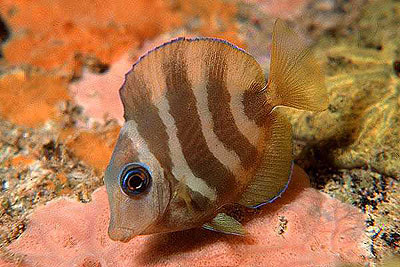
As the fish matures into the intermediate phase, the color darkens to a bright blue or purplish-gray with a yellow caudal fin. Gray longitudinal lines are located in the flank region with blue dorsal and anal fins banded with orange-brown diagonal lines. The caudal spine is yellow to pale yellow or white. At night, blue tangs display white vertical stripes.
Adult blue tangs are deep blue to purplish-blue with a yellow caudal spine. The change from juvenile to intermediate to adult coloration is not size-dependent as some fish in the juvenile yellow phase may be larger than the adult blue phase.
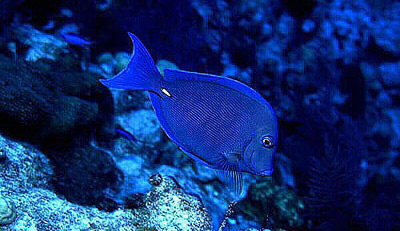
Dentition
The close-set, spatulate teeth of the blue tang are well adapted for nipping, grazing, and browsing algae from the reef. There are 14 teeth on the upper jaw and 16 teeth on the lower jaw.
Size, Age, and Growth
The blue tang reaches approximately 12 inches (30.5 cm) in length. The largest specimen, caught off the coast of South America, measured 14.4 inches (37 cm). It reaches sexual maturity at 9-12 months of age and lengths of 4-5 inches (11-13 cm).
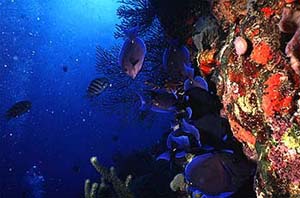
Food Habits
This fish feeds entirely on algae. It grazes algae from rocky areas and browses filamentous algae, thereby avoiding large quantities of calcareous materials. Other surgeonfishes have heavier-walled, gizzard-like stomachs, and are capable of handling ingested sand and other calcareous materials. Blue tangs are important in keeping algae populations under control, preventing algae from overgrowing and suffocating corals.
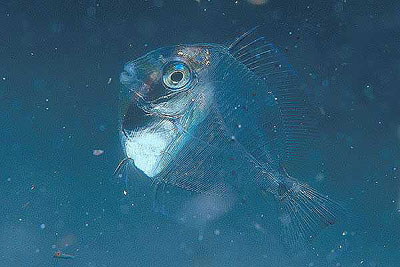
Reproduction
Spawning occurs during late afternoon and evening hours. This event is indicated by a change in color from a uniform dark blue to a pale blue anterior and dark blue posterior. Males aggressively court female members of the school, leading to a quick upward spawning rush toward the surface of the water during which eggs and sperm are released. The eggs are small, approximately 0.8mm in diameter. The eggs are pelagic, each containing a single droplet of oil for flotation. The fertilized eggs hatch in twenty-four hours, revealing small, translucent larvae with silvery abdomens and rudimentary caudal spines.
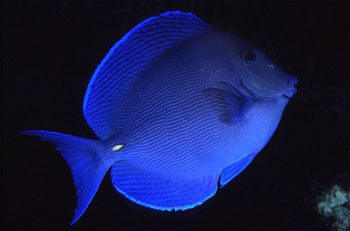
The newly hatched larvae are referred to as acronurus because they were once thought to represent a separate genus of fish, Acronurus. The acronurus is diamond-shaped and laterally compressed, with a head shaped like a triangle. It has large eyes and prominent pectoral fins, and vertical ridges on the body. The dorsal fins, anal fins, and scales begin to develop when the acronurus reaches 2-6 mm in length. The caudal spine does not appear until the acronurus reaches about 13 mm in length.
Late post-acronurus drift inshore, where they metamorphose into juveniles. The acronurus lose their silver color and turn brown, and their profiles become round. The prominent dorsal and anal spines that are characteristic of the acronurus reduce, and the snout elongates. Complete metamorphosis takes about a week, after which two-inch long juveniles settle onto the bottom of a suitable inshore habitat.
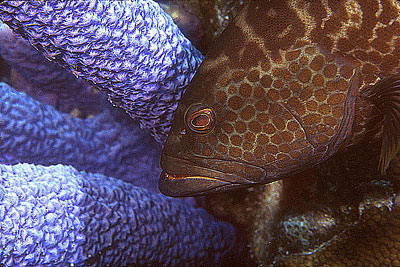
Predators
Tuna, bar jack, tiger grouper, and other large carnivorous fishes are known predators of the blue tang.
Taxonomy
The blue tang is one of 75 species in the surgeonfish family, Acanthuridae. This family of fishes are referred to as surgeonfish due to the very sharp, movable spines on either side of the tail that resemble surgeons’ scalpels.
The blue tang was first described as Acanthurus coeruleus by Bloch and Schneider in 1801. Acanthurus is derived from the Greek “acantha” which means thorn, and the Greek “oura” which means tail. Synonyms used to refer to the blue tang include Acanthurus broussonnetii Desmarest 1823, Acanthurus violaceus Castelnau 1855, Acanthurus brevis Poey 1860, Acronurus caeruleatus Poey 1875, Acanthurus heliodes Barbour 1905, Teuthis helioides Barbour 1905, andHapatus pawnee Breder 1927.
Prepared by: Cathleen Bester